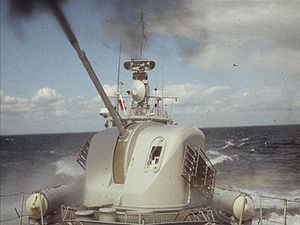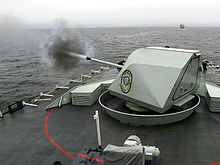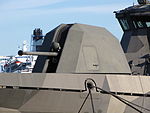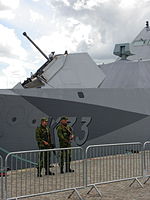- Bofors 57 mm gun
-
Bofors 57 mm 
A Bofors 57 mm Mk 1 live-firing on the Swedish Spica-II Class FACType Naval artillery Place of origin Sweden Service history In service 1966 - present Used by See users Production history Designer Bofors Defence Designed • Mark 1: 1964
• Mark 2: 1981
• Mark 3: 1995Manufacturer • Bofors Defence (1966-2000)
• United Defense (2000-2005)
• BAE Systems AB (2005 onwards)Produced • Mark 1: 1966
• Mark 2: 1985
• Mark 3: 2000Variants See variants Specifications Weight Mark 3: 14,000 kg (31,000 lb) (weight including 1,000 rounds onboard)
6.5 kg (14 lb) (complete round)Barrel length • Bore length: 3,990 mm (157.09 in)
• Without flash hider:4,045 mm (159.25 in)
• With flash hider: 4,345 mm (171.06 in)Shell 57 mm × 438 mm
6.1 kg (13 lb) complete round
2.4 kg (5.3 lb) pre-fragmented shellCaliber 70 caliber 57 mm Barrels Single barrel (progressive RH parabolic twist, 24 grooves) Action Electronic firing Elevation • Mark 1: -10°/+78°(40°/s)
• Mark 2: -10°/+75°(40°/s)
• Mark 3: -10°/+77°(44°/s)Traverse Full 360°
• Mark 1 & 2: 55°/s
• Mark 3: 57°/sRate of fire • Mark 1: 200 rounds/min
• Mark 2 & 3: 220 rounds/minMuzzle velocity 1,035 m/s (3,400 ft/s) (HE round) Effective range 8,500 m (9,300 yd) (HE round) Maximum range 17,000 m (19,000 yd) (HE round at 45°) Feed system Magazine:
• Mark 1 - 40 ready rounds, 128 rounds in ready racks in mount.
• Mark 2 - 120 ready rounds, up to 40 rounds in dual hoists.
• Mark 3 - 120 ready rounds, up to 40 rounds in dual hoists, 1,000 rounds in mounting.Sights Gyro-stabilized in local control. The Bofors 57 mm guns are a series of dual-purpose naval guns designed and produced by the Swedish defence firm of Bofors Defence (the company was acquired in September 2000 by United Defense Industries but is now a part of BAE Systems AB since March 2005). Designed in 1964, production of the baseline 57 mm Mark 1 variant began in 1966 and was used to equipped initially smaller coastal patrol craft and fast attack craft. The gun was upgraded and improved several times, first as the Mark 2 in 1981 and the Mark 3 in 1995.[1]
Most recently, it was offered by BAE Systems AB (successor of Bofors Defence AB) as the Mk 110 57 mm gun (essentially a slightly modified Mark 3) for use by the United States Coast Guard in 2004 and the United States Navy in 2006.[2]
The gun is usually controlled by a fire-control computer but as a redundancy measure, the crew can also train and aim the gun using instrument panels that are either on or in direct contact with the gun.[1]
Although the Swedish Navy is the primary user of the gun, it has been exported widely by Bofors Defence for use by the navies of Brunei, Canada, Croatia, Finland, Indonesia, Ireland, Malaysia, Mexico, Montenegro, Singapore, Thailand and the United States.
Contents
Design and development
The baseline version of the Bofors 57 mm (2.2 in) L70 gun was the Mark 1, first introduced into service with the Spica-class fast attack craft (FAC) of Swedish Navy in 1966, it has a rate of fire of 200 rounds per minute and a 40-round magazine in the gun turret with a further 128 rounds stowed inside. With minor modifications, the Mark 1 guns could use ammunitions developed for the Mark 2 gun.[1]
The Mark 2 was designed in 1981 but introduced into service with the Stockholm-class corvette - HMS Stockholm (K11) in 1985 (sister ship HMS Malmö (K12) was built in 1984 but armed with the older Mk 1, subsequently retrofitted with the Mk 2 in 2009), the rate of fire was slightly increased to 220 rounds per minute. Also, it featured a new light weight gun turret with a new gun barrel that was forged from monobloc steel (this eliminated the need to use a water jacket for gun barrel cooling during firing) and a new servo drive/servomechanism system (for faster reaction time and better gun aiming and control). According to Bofors, the new servo system allowed the Mk 2 to be both accurate and agile enough for used against sea skimming anti-ship missiles and that it could put more explosives into a surface target within a thirty seconds window than any naval gun with a calibre smaller than 100 mm (3.9 in).[1]
The latest development is the Mark 3, which was designed in 1995 but introduced into service with the Visby-class corvette - fitted on HMS Visby (K31) in 2000. This new design retained the Mark 2 gun turret, rate of fire and ammunition capacity and has another 1,000 rounds stowed in the standby rack beneath deck. A small radome has been added above the gun barrel and is used for measuring the muzzle velocity of the departing projectiles for fire-control purposes, usually but not necessarily with the new Bofors 57 mm 3P all-target programmable ammunition. Also, a new optional low radar profile (also known as low radar cross-section, or RCS) stealth mounting was developed, this allows the gun to be hidden from radar and plain sight when not in use.[1]
In American service, the United States Navy has designated the Mark 3 as the Mark 110 Mod0 57mm gun. According to a BAE press release dated 1 August 2005, the Mark 110 would be manufactured at the BAE Systems facility in Louisville, Kentucky.[1]
Ammunitions
Ammunitions for the Bofors 57 mm gun are produced by Bofors, Sako Limited in Finland, SME Ordnance in Malaysia and Nammo in Norway.[1]
Since 2006, BAE Systems AB began to offer the Bofors 57 mm 3P all-target programmable ammunition, this allows 3 proximity fuzing modes as well as settings for time, impact, and armor piercing functions. This increases the flexibility and effectiveness of the gun system, which has further reduced the reaction time of the gun and it is possible to choose ammunition mode at the moment of firing, giving it the ability to switch rapidly between surface targets, air targets as well as ground targets.[3]
Variants
Bofors 57 mm/L70
- Bofors 57 mm Mk 1
Bofors developed the Mark 1 from the Bofors 57 mm/L60 in 1962. Improvements included a higher rate of fire, the use of new munitions including an improved proximity fuse, water cooling for the gun tubes and a new electro-hydraulic system for rapid training and elevation. Finland, Malaysia, Norway, Indonesia, Singapore and (the former) Yugoslavia are among the countries that adopted the Mark 1.
- Bofors 57 mm Mk 2
The Mark 2 was a lighter weight version, which utilized a new servo system. Bofors designed the gun in 1981 and it entered active service on the Stockholm-class corvette in 1985. The gun was partly dual-purpose in the sense that it is accurate and agile enough to destroy sea-skimming missiles. Bofors manufactured a total of about 25 Mk 2 guns.[1]
- Bofors 57 mm Mk 3
The Mark 3 is the latest version of the gun. Bofors designed it in 1996 and it entered service in 2000. The gun uses smart ammunition but can also fire the same ammunition as the Mk 2. The stealth variant has a reduced radar profile, in part by hiding the gun barrel when it is not firing. Also, the gun has a small radar mounted on the gun barrel to measure muzzle velocity for fire control purposes and it can change ammunition types instantly due to a dual-feed system.[2]
- Mk 110 57 mm gun
The Mark 110 57 mm gun is the US version of the Bofors 57 mm Mark 3 gun, while the Bofors 57 mm 3P ammunitions are designated as Mark 295 Mod0 in US service.[1]
Users
- Mark 1
 RSS Sea Dragon with its 57 mm Mk 1
RSS Sea Dragon with its 57 mm Mk 1
 Croatia:
Croatia:
 Finland:
Finland:
 Indonesia
Indonesia
- Andau class (Lürssen FPB 57-I[4])
- Mandau class (modified version of the South Korean Navy's Bae Ku class, which was based on the U.S. Navy's Asheville-class gunboat)
 Ireland
Ireland
 Malaysia:
Malaysia:
- Kasturi-class frigate
- Perdana class (Combattante-II 4AL[4]) missile boat
- Handalan class (Spica-M)
- Jerong class (Lurssen TNC 45[4])
 Montenegro:
Montenegro:
 Singapore:
Singapore:
- Sea Wolf class (Lurssen TNC 45[4])
 Sweden:
Sweden:
- Hugin class
- Spica class
- Spica II class
 Thailand
Thailand
- Prabbrorapak class (derivative of Singapore's Sea Wolf class, which was based on the Lurssen TNC 45[4])
- Mark 2
 Canada:
Canada:
 Indonesia
Indonesia
- Pandrong class/Todak class (2 and 4 ships respectively) (Lürssen FPB 57-II[4])
 Malaysia:
Malaysia:
 Sweden:
Sweden:
- Mark 3/Mk 110 57 mm gun
The 57 mm Mk 3 on the bow of a Hamina-class missile boat, note the prominent but small radome above the gun barrel which is used for measuring muzzle velocity of the departing projectileThe 57 mm Mk 3 in a stealth cupola aboard a Visby-class corvette, the stealth version of the Mk 110 57 mm is similar in appearanceUSS Freedom (LCS-1) firing its Mk 110 57mm gunComparisons between the Mark 3 guns  Brunei:
Brunei:
- Offshore Patrol Vessel[5]
 Finland:
Finland:
 Mexico:
Mexico:
- Sierra-class corvette
- Durango-class patrol vessel
 Sweden:
Sweden:
 United States:
United States:
See also
- Bofors 40 mm
- List of naval guns by caliber
References
- ^ a b c d e f g h i "Sweden 57 mm/70 (2.25") SAK Marks 1, 2 and 3 / United States 57 mm/70 (2.25") Mark 110 Mod 0". NavWeaps.Com. 10 April 2008. http://www.navweaps.com/Weapons/WNSweden_57-70_mk123.htm. Retrieved 22 September 2011.
- ^ a b c d e "57-mm Mk 110 Mod 0 Naval Gun System". BAE Systems. http://www.baesystems.com/ProductsServices/l_and_a_sea_mk110.html. Retrieved 22 September 2011.
- ^ "40 and 57 mm 3P ammunition". BAE Systems. 2006. http://www.baesystems.com/ProductsServices/l_and_a_bof_3p.html. Retrieved 22 September 2011.
- ^ a b c d e f "Naval vessels as built by Lurssen GmbH". Lurssen.com. http://www.luerssen.de/en/frameset.naval.html. Retrieved 22 September 2011.
- ^ "Mindef Accepts 2 Darussalam-Class Offshore Patrol Vessels" (Press release). Government of Brunei. http://www.gov.bn/en/News/Pages/Mindef-Accepts-2-Darussalam-Class-Offshore-Patrol-Vessels.aspx. Retrieved 22 September 2011.
External links
- BBC article
- Bofors Defence - Naval Guns and Programmable Ammunition
- Bofors 57mm MK3 Naval Gun System
- Jane's info on Bofors 57 mm gun
- NavWeaps.Com: Bofors 57 mm/60
- Video links
Categories:- Naval anti-aircraft guns
- 57 mm artillery
- Naval artillery
- Artillery of Sweden
- Naval guns of the United States
- United States Coast Guard weapons
- Bofors
Wikimedia Foundation. 2010.




